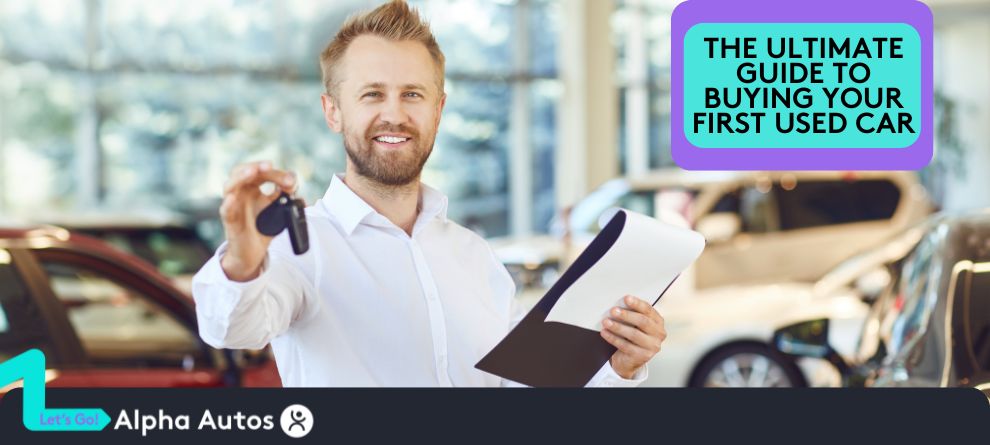

The Ultimate Guide to Buying Your First Used Car
Imagine the open road stretching before you, the wind in your hair (or sunroof, if that’s your style) – the thrill of owning a car is undeniable. It’s a gateway to independence, adventure, and the ability to explore on your own terms. But let’s be honest, that shiny new car can come with a hefty price tag. As a first-time buyer, that dream can feel frustratingly out of reach.
The good news? You don’t have to wait! The used car market presents a wonderful option. Here are reasons why purchasing a second-hand vehicle could be the right decision for you:
- Affordability: The price of used cars is much less than that of new ones, making it easier to buy the car you have always wanted.
- Variety: The market for second-hand cars is full of various brands, types and options to fit every taste and requirement.
- Lower Initial Investment: Initial investment is lower; you dodge the big loss in value that new cars suffer as soon as they leave the dealership.
However, navigating the used car market can feel overwhelming. Don’t worry, we’ve got you covered. This guide will equip you with the knowledge and tools to become a confidently used car buying pro!
Researching Like a Pro: Mastering the Art of the Used Car Deal
Budget Basics: Building Your Financial Roadmap
Before you start looking at houses, first take some time to think about your budget. Remember that it’s not only the buying price that matters. Consider ongoing costs like:
- Insurance: Insurance costs change based on things such as how old you are, your history of driving, and what kind of car you have. You should ask for price estimates from various companies.
- Registration: Fees will depend on your location and the car’s value.
- Maintenance: Even reliable cars need upkeep. Factor in regular servicing and potential repairs.
There are many online resources and budget calculators to help you create a realistic spending plan.
Choosing the Right Ride: It's All About Your Needs

Now we come to the enjoyable section – choosing the best car. Here are important questions for you to think about:
- Lifestyle consideration: For what purposes do you plan to use the car? Is it for everyday travel to work, trips at weekends or maybe transporting a larger family?
- Cargo Space: Do you need room for groceries, camping gear, or sports equipment?
- Passenger Capacity: How many people will you be driving regularly?
- Fuel Efficiency: Gas prices have changed a lot. It’s better to choose cars that use less gas so you can save money over time.
After knowing what you need, look for well-known second-hand car types in the category of your choice. Study critiques, examine specifications and become aware of the available options.
Prioritising Your Needs: Must-Haves vs. Nice-to-Haves

Let us be honest, each person enjoys having a sunroof and seats that warm up. However, when considering car features, choose the ones that are important.
Each of us holds certain ideal features in a car that impress us when we find them mentioned. However, when purchasing a pre-owned vehicle, it is crucial to distinguish between the features we desire and those we truly require. Here’s how to prioritise effectively:
Must-Haves: The Features That Matter Most
- Safety First: Safety is the most important thing. Choose a car that has a high safety score from well-known groups such as the National Highway Traffic Safety Administration or the Insurance Institute for Highway Safety, which tells about how safe cars are. Essential safety features include:
- Multiple airbags: Airbags in many places, like the front of the car, at the sides and above your head can make it much less likely to get hurt if you have an accident.
- Anti-lock Braking System (ABS): Anti-lock Braking System (ABS) stops wheels from getting stuck when you brake strongly, so you can still control the steering in urgent situations.
- Electronic Stability Control (ESC): Electronic Stability Control, or ESC, assists in preventing the car from losing control by automatically applying the brakes and modulating engine power when a skid happens.
- Technology for Daily Use: Think about functions that improve your experience and safety while driving. Some examples are:
- Backup Camera: A lifesaver when reversing, especially in tight spaces or with limited visibility.
- Blind-Spot Monitoring alerts you to cars in your blind spot, helping to lower the chance of crashes when changing lanes.
- Bluetooth Connectivity: Bluetooth feature lets you link your phone to make calls without using your hands and play music, helping you concentrate on driving.
Nice-to-Haves: The Features That Add Comfort (But Not Necessity)
It is true, some functions are very impressive. However, it is important to make sure that they do not cost too much or compromise necessary safety elements. Here are some popular “nice-to-haves”:
- Sunroof allows you to feel a bit of the outside breeze, but it might let water in and make fixing things more complicated.
- Warm seats are nice on chilly mornings, though they aren’t essential for most drivers.
- Great sound system for people who love high-quality audio, but a normal sound system is often enough for many.
- Navigation System: Smartphone navigation apps can be a more affordable alternative.
Finding the Perfect Balance
Make a list of the important features you need and put less important ones aside, so you can choose a car that fits your main needs and stays within your spending limit. It’s possible to install extra things like Bluetooth or new sound systems after buying the car.
The most important thing is to put safety, how well it works, and if you can count on it first. These qualities will make sure your drive in the used car is comfortable, pleasant and above all, secure.
Inspecting Used Cars: Unveiling Your Potential Ride
You have done your research, made a budget and now you have a list of potential used cars. Next is the thrilling but perhaps daunting step: checking the car! Here’s a roadmap to guide you through the process:
Checking Mechanical Components: Under the Hood and Beyond
Although it’s not necessary to have mechanical skills, there are several important mechanical inspections you can carry out.
- Engine: Examine the engine for any leaks or cracks and check if belts and hoses have too much wear. Also, listen carefully to see if there are strange sounds such as knocking or ticking while the engine operates.
- Fluids: Examine the engine oil, transmission fluid, coolant and brake fluid for their color and thickness. If fluids are looking dirty or have a different color, this might show there could be issues.
- Tyres: Check the depth of the tread and look carefully at the condition for any signs that show uneven usage, slices or swelling on them. Make sure every tire, including your extra one, has enough air inside it.
- Test Drive: It is very important to notice how the car behaves. Look out for strange shaking, if it moves more to one side, or problems when you try to brake because these might show there are some hidden problems.
Evaluating Exterior and Interior Condition
The car’s condition speaks volumes. Here’s what to look for:
- Exterior: Outside, look for any small dents, scratches, spots of rust or areas where the paint does not match. If the spaces between panels are not even or if doors do not line up correctly, it might mean there was damage from an accident before.
- Interior: Inside the car, look for any rips, tears or stains on the seat covers. Try out all seats and make sure windows open and close correctly. Check that locks are working fine and test every light as well as electronic functions to confirm everything is in good order. Check for water harm or signs of mold, particularly on the carpets and beneath the mats on the floor.
Understanding Vehicle History Reports: Decoding the Car's Past
It is very much suggested to buy a report on the vehicle’s history. The report gives important details about what has happened with the car before, such as:
- Accident history: Has the car been in any major accidents?
- Maintenance records: Has the car been properly serviced according to the manufacturer’s recommendations?
- Ownership history: How many previous owners has the car had?
- Mileage accuracy: Is the odometer reading consistent with the car’s condition and service records?
With this information, you understand better the car’s condition and what it might need later. It can also help when discussing the price with the person selling the car.
Remember: Keep in mind, asking questions is good. If someone sells cars well, they should give clear information about the car’s past and how it is now.
Finalising the Purchase: Bringing Your Dream Car Home

Congratulations, you have found the right second-hand car – now it is time to finalize the purchase. Here’s what to expect in the final stages:
Completing Necessary Paperwork
The seller will likely handle most of the paperwork, but it’s important to understand what you’re signing. This might include:
- Bill of Sale: This document transfers ownership of the car from the seller to you.
- Registration Certificate: This is proof of ownership in Australia. You’ll likely need to apply for a new registration certificate in your name at your local Department of Transport (DoT).
- Registration: This refers to getting your car registered to operate legally on the road. You’ll need to register the car in your name and pay any associated fees.
Transferring Ownership
Based on where you are, it is possible that the seller will take care of changing the title over to your name or perhaps both of you should go to the DMV for this. Be certain that every document needed is correctly filled out and ready before you complete buying the car.
Taking Possession of the Vehicle
After all the documents are signed and everything is in order, it’s time to begin the journey. Before you start driving, make sure again that you have:
- Proof of insurance: This is mandatory to operate a vehicle legally.
- Manual for owner: It contains crucial details about when to maintain the car and ways to use its functions.
- Keep the extra key and all maintenance records; they are important for when you need to fix or service your car later.
After-Purchase Maintenance and Care Tips
You have my congratulations for now being the owner of a second-hand car. Next, you must take care of your new vehicle to keep enjoying this freedom. Here are some essential tips:

Regular Maintenance Schedule:
- Check the owner’s guide; it shows you when to change oil, replace filters, and do regular service jobs.
- Following the timetable: It is very important to do regular upkeep to avoid issues and make your car last longer.
Tips for Extending the Lifespan of a Used Car:
- Quality oil changes: For good oil changes, it is important to use the oil type that is suggested and change it when the time comes.
- Gentle driving habits: Avoid harsh acceleration, sudden stops, and overloading the car.
- Perform regular checks: Search for evidence of usage, any leaking or possible issues. Take care of anything you worry about without delay.
Dealing with Unexpected Repairs:
Even a very dependable second-hand car might need some fixing after a while. This is the way to manage those repairs:
- Get quotes from multiple mechanics: Don’t settle for the first estimate you receive.
- Regular inspections: Think about using authentic or superior aftermarket components; they provide a good mix of being cost-effective and dependable.
- Budget for repairs: Set aside some money for unexpected maintenance costs.
Conclusion: The Road Ahead with Your Used Car
Having a second-hand car gives you the chance to experience freedom, go on adventures, and feel happiness when driving freely. If you use this guide’s steps, it will help you understand how to buy a used car with certainty. Keep in mind to first consider what you need, look for information carefully, and feel confident to discuss the price. If you prepare well and know a bit about it, you can discover the right second-hand car that meets your spending limit and suits how you live; it will carry you along all paths of life.
Happy driving!
Looking for a Quality Used Car in Brisbane?
Brisbane’s Alpha Autos offers a wide range of reliable, affordable used cars. From city-friendly hatchbacks to family SUVs, they’ve got you covered. Their experienced staff will help you find the perfect car, and all vehicles come inspected with a warranty for peace of mind. Visit Alpha Autos today and drive away happy!
Related posts





